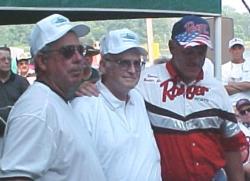Heroes for a day, heroes forever
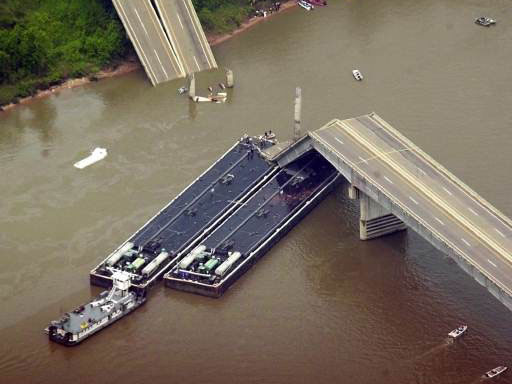
Bass anglers save lives following Oklahoma bridge collapse
It was 7:45 Sunday morning, May 26, Memorial Weekend. Oklahoma bass anglers Alton Wilhoit and Kirk Washburn had just set up camp along the bank of the Arkansas River about a hundred yards north of the Interstate 40 bridge that spans the river in eastern Oklahoma. At the same time about 600 yards upriver, anglers Randy Graham and Norman Barton Jr. were running south at close to 70 mph toward the same bridge.
That’s when the bridge collapsed.
“We just heard a low boom,” said Washburn, who hails from the Oklahoma City suburb of Harrah. “It didn’t sound like there was any metal scraping or anything like that.”
“Actually, we could even feel it,” said Wilhoit, also from Harrah. “We had our backs to it. When we turned around we were looking for a bad accident or something on the bridge, but it was in the process of collapsing.”
“I grew up here,” said Barton, who calls nearby Vian, Okla., home. “I knew right away what it was when I saw it happen, but I didn’t comprehend it. I just turned to my partner and said, `I-40 just fell.'”
Driving into thin air
They were all fishing in a Jimmy Houston Outdoors team tournament that Sunday. About 170 boats had taken off from the nearby river town of Webbers Falls earlier that morning.
At 7:45 a.m., a hundred-foot tugboat pushing two 500-ton barges slammed into bridge supports on the western end of the 2,000-foot span of I-40 over the Arkansas River. The crash caused a 580-foot gap to open up as the bridge collapsed into the river below.
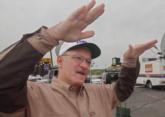 “I kept seeing splash, splash, splash,” said Barton. “I thought it had blown up and those were pieces of the bridge hitting the water. Then we realized that they were cars going down.”
“I kept seeing splash, splash, splash,” said Barton. “I thought it had blown up and those were pieces of the bridge hitting the water. Then we realized that they were cars going down.”
“All I could think of was to get over there as quick as we could,” Wilhoit said. “We fired up the (boat) motor and we were there in 15 seconds.”
“As we were running over there, we saw one truck with a horse trailer go off the east side of the bridge, then a motor home,” said Washburn.
Said Barton, “They just kept plunging off the bridge. Nobody had a clue it was gone.”
The I-40 bridge over the Arkansas River is located about a hundred miles east of Oklahoma City. Situated not too far from the Arkansas border, that section of highway is part of the main artery carrying traffic between Oklahoma and Arkansas. According to transportation officials, the bridge has an average traffic count of 18,500 vehicles per day in the westbound lanes and 19,200 in the eastbound lanes.
The way the bridge collapsed and the way the roadway is situated left travelers with zero warning that they were about to plunge into the river. The break occurred at an arch where the road comes to a rise, particularly for westbound traffic. Vehicles moving at 70 mph close to the collapse didn’t have a chance.
“They would come off the bridge and go a long ways,” said Washburn. “The cars weren’t slowing down at all. They were just driving off into thin air. When they hit the water, there would be an explosion of water and then there wouldn’t be anything – no bobbing or anything. They were just gone.”
Several tournament boats in the area – including those occupied by Wilhoit and Washburn, and Barton and Graham – saw what happened and moved into action. Wilhoit and Washburn maneuvered up to the bridge and began yelling and screaming in an attempt to get traffic to stop. It was a futile effort; no one could see or hear them. For several minutes they watched helplessly as cars, trucks and semitrailers continued to plunge some 62 feet down into the river.
Wilhoit estimated that he saw at least nine vehicles pile over the end of the broken bridge, including several semi trucks. “I think the semis were the most dramatic,” he said. “They just crested the arch and went off.”
“At first it was just disbelief, like it was in slow motion,” said Washburn. “What we came to realize was that there were more and more cars coming off the bridge, and that was the frustrating part.”
One-in-a-million shot
Unable to capture the attention of the oncoming traffic with their voices, Wilhoit and Washburn pulled their boat back away from the bridge so they could try and see the top of the bridge better. While Washburn dialed 911 on his cell phone, Wilhoit remembered that he had a flare gun in his boat. That recollection turned out to be one of the most inspired moments of heroism in the face of the tragedy that day.
Wilhoit loaded and fired the plastic pistol. The flare sailed over the bridge right in front of an oncoming semi truck in the westbound lane, which proceeded to hit the brakes and skidded to a stop not more than 15 feet from the edge of the bridge gap. That truck then backed up quickly, blocking traffic and crashing into vehicles behind it. The deadly flow of traffic from that direction had stopped.
“Alton is the one who saved the day,” said Barton, who witnessed Wilhoit fire the flare gun. “He’s the hero of the bunch. It looked to me like he bounced (the flare) right off the front of the semi.”
Carl Woods, tournament director for Jimmy Houston Outdoors Tournament Trails, was having coffee at the boat ramp located about a third of a mile upriver from the bridge when he saw it collapse.
“It’s a very helpless feeling. I simply lost count of the exact number (of vehicles) that I saw fall,” he said. “Then I saw the flare go up. At the time I thought that something in the water had exploded. Then I heard and saw the semi skidding its wheels and finally stopping. The flare and the semi that stopped kept other vehicles from running off the bridge.
“If Alton hadn’t made that one-in-a-million flare shot, more would have driven off the bridge. I don’t know – and he doesn’t know – how he made that shot. … It was wonderful.”
About nine years ago, Wilhoit purchased the flare pistol in response to instructions in a registration packet for an out-of-state regional tournament. Most anglers don’t carry signal flares because most tournaments don’t require them, but Wilhoit noticed the small print for that event and followed it to the letter.
“At first I thought it was ludicrous,” he said. “But I’m the type of guy who, if I turn without signaling when I’m driving, I’m going to get a ticket.”
Stuck in the bottom of a storage compartment in his boat, Wilhoit forgot about the pistol until last year at an EverStart Series tournament at Mississippi’s Lake Ferguson when the Coast Guard pulled him over and asked to see his safety flares. When he produced the gun, they told him that the flares were out of date.
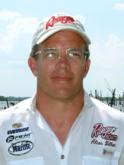 “I test-fired it twice after the tournament to see if it worked, put it back in my boat and never thought about it,” he said.
“I test-fired it twice after the tournament to see if it worked, put it back in my boat and never thought about it,” he said.
As cars and trucks piled off the end of the collapsed I-40 bridge, one of Wilhoit’s first instincts was to reach for the safety flares. He had two flares left in his possession. However, when he loaded the plastic pistol and pulled the trigger the first time, it didn’t fire. The first old flare was a dud. He reloaded with the second flare, and this time it worked. The flare took a true flight directly in front of the oncoming semi, and it saved the lives of many.
“The thing is,” recalled Wilhoit, “if it had gone off the first time, probably no one would have seen it.”
First rescue
With the traffic stopped – from both directions, traffic coming from the eastbound lanes had halted on its own accord – Wilhoit and Washburn sprang into rescue mode, disregarding concern for their own safety in the process.
“Once the cars quit coming off, we went right over to the bridge and started going through the debris,” said Wilhoit. “We heard a guy yelling from the debris by the barge.”
The water on the Arkansas River was running high that day. As they approached the disabled barge and the man in distress, the heavy current took hold of Wilhoit’s boat and pinned it against one of the bridge’s support columns amongst a mess of tumbled concrete and rebar.
In the water was a man named Rodney Tidwell. A truck driver from Ripley, Miss., he had been hauling a load of rubber hoses to Sparks, Nev., when the I-40 bridge collapsed underneath him. He fell the 60-some odd feet into the river and somehow – he doesn’t remember doing it – managed to escape the truck’s cab.
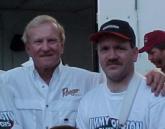 When Wilhoit and Washburn approached him, Tidwell was treading water amongst the hoses and other debris that had floated to the river surface. But the anglers couldn’t reach him due to the heavy current and debris, so Washburn stepped over the jumble of rebar and threw him a line with a throw cushion attached to it. Tidwell, though suffering from lacerations, was alert and able to hold on as they reeled him in about 10 feet to the boat.
When Wilhoit and Washburn approached him, Tidwell was treading water amongst the hoses and other debris that had floated to the river surface. But the anglers couldn’t reach him due to the heavy current and debris, so Washburn stepped over the jumble of rebar and threw him a line with a throw cushion attached to it. Tidwell, though suffering from lacerations, was alert and able to hold on as they reeled him in about 10 feet to the boat.
“As he was getting hold of (the rope), we spotted another gentleman about 15 feet to his right,” said Washburn. “Mr. Tidwell said, `There’s another guy that way!’ We could see that (the other guy) was starting to panic a little bit, but we couldn’t push the boat that direction because of the current.”
Second rescue
Caught up in the current against the bridge pier, Wilhoit and Washburn were unable to reach the second man. The victim, James Bilyeu of Conway, Ark., was another truck driver who had gone over the edge, and he appeared to be in great distress. He was floundering amongst the debris underneath the overhang at the base of the big barge, battling the swift current as it tried to push him underwater and underneath the barge.
“We couldn’t get there, and I remember him saying, `I can’t hang on any longer!'” Wilhoit said.
At that point, Graham and Barton pulled up in their boat. Earlier, when they had seen the bridge fall, they had returned to the boat ramp to notify Woods. Then they had turned right back around and had raced to the accident site. They pulled up as Wilhoit and Washburn tried futilely to reach Bilyeu.
“They said, `There’s a guy under there!’ So we ran the boat right up under the barge,” said Barton. “If we would have turned sideways, we would have gotten pinned, too, and might have gone under the barge. How smart was that? Under normal circumstances, probably not very, but these weren’t normal circumstances.”
Bilyeu struggled mightily to stay on top of the water and avoid being swept underneath the barge. The rescuers had precious little time to act.
“He was hollering, `Save me! Save me!'” said Barton. “There were probably just seconds until Mr. Bilyeu was gone.”
Adding to the confusion was the fact that the anglers couldn’t initially find Bilyeu among the debris.
“We finally spotted him by the blood on his face,” said Barton. “It was such a contrast to the mix of brown water, boxes and stuff.”
While Graham manned the controls and held the boat in position underneath the massive barge, Barton quickly threw Bilyeu a rope and a seat cushion. Somehow, the injured and exhausted man was able to grab the rope and wrap it around his wrist. Then he went under. The force of him hitting the rope nearly yanked Barton out of the boat, but the determined angler held on.
“I got him to the side of the boat, grabbed his arm and a handful of clothes and yelled at Randy to get us out of there, out from under that barge,” said Barton.
Back out in safer water, the two anglers hoisted the bridge victim to the boat deck. Badly injured and disoriented, Bilyeu said repeatedly, “You saved my life.”
Third rescue
Graham and Barton returned to the boat ramp with Bilyeu, who had a broken arm and two broken ribs and needed immediate medical attention. Meanwhile, Wilhoit and Washburn remained at the barge to search for more survivors for several minutes.
“At that point, Rodney (Tidwell) didn’t appear to be hurt that badly,” Wilhoit said, “so we idled around for two or three minutes in the debris looking for other people. But we couldn’t get any response.”
Elsewhere near the wreckage, John and Gabriel Swain, a father-and-son fishing team out of Tulsa, had rescued a third survivor. Richard Cawley of Lebanon, Ore., and his wife Jeanine were on a cross-country trip in their pickup when they went off the bridge. Cawley had managed to extract himself from his submerged vehicle but was unable to free his wife. In the process of escaping, Cawley’s truck had rolled over onto his arm and had pinned him. By the time he was able to pull free, he had to head to the surface for air.
When the Swains found him, Cawley had a badly severed arm. “I just remember John saying, `We’ve got to take this gentleman to the ramp right now,'” said Washburn.
Back at the ramp, Woods was helping Graham and Barton attend to Bilyeu when the Swains came in with Cawley. John Swain had used his belt as a tourniquet on Cawley’s arm and made an attempt to adjust it once back on land, but the bleeding was too profuse to loosen it. They left the tourniquet as it was until ambulances arrived several minutes later.
The aftermath
Wilhoit and Washburn searched through the wreckage for survivors until more help arrived minutes later. By that time, some 12 or so additional tournament boats had pulled up and joined rescue efforts, so the anglers returned to the ramp with Tidwell.
Later, after ushering the three victims into emergency care at the ramp, the six rescuers returned to the water and the crash site. They and other Jimmy Houston anglers became instrumental to the rescue operation as they hauled emergency teams and equipment to the fallen bridge and searched for victims.
“If anything was fortunate about that situation, it was that tournament fishermen were there,” Barton said. “We all have experience in how to handle that kind of swift water. The people who were there first were experienced boat handlers.”
Rescue efforts continued throughout the day as anglers and tournament officials lent a hand any way they could – carting emergency personnel and divers around, cooking food for workers and searching for any survivors. As that day turned into the next, and the next, the rescue operation evolved into a recovery operation as no more survivors were found. A total of 14 people died in the tragic bridge accident that day, including one 3-year-old girl traveling with her parents.
“The hardest part for me was two hours after it happened,” Barton said. “We were helping search for survivors. We were way down the bank looking for shoes, clothing – anything you might have in a vehicle – when we came across a whole bunch of diapers and a baby’s car seat. I have a 2-year-old daughter myself, so that hit me really, really hard. My legs were shaking. Then I turned around and saw a black-and-white teddy bear floating down the river. All I could think about at that moment was coming home and hugging my kids.”
But three of the bridge victims survived. Three innocent victims – people who had unexpectedly plunged more than 60 feet into freezing, fast, murky water amidst tons of rubble and falling vehicles, and who had no earthly business making it out alive – are alive today. They survived due to the heroic efforts of six brave, expeditious fishermen.
These men have tasted glory before, at least as far as their respective efforts in competitive fishing are concerned. Barton, Wilhoit and Washburn are Wal-Mart BFL Okie Division standouts, each having qualified for the All-American before. Washburn won the division last year. He and Wilhoit are sitting in third and second place, respectively, in the 2002 standings with only the Super Tournament left to fish. But glory at the weigh-in podium by no means prepared these men for what they saw and did that Memorial Weekend day on the Arkansas River.
Confronted with the idea that they are heroes – which they are, in the truest sense of the word – they shied away from the suggestion.
“I guess I wouldn’t know what (a hero) feels like,” said Washburn. “We just reacted to the situation. I hope that we did what anybody would do. It was all instinct. … The hardest part about it is the injustice of it all. The ones who didn’t make it, those people had done nothing to deserve this.”
Barton agreed. Remembering how he felt as he watched helplessly as cars soared off the bridge, he said, “We didn’t get a chance to make enough of a difference. … I find that my mind wanders. It’s going to do that for a long time, I’m sure.”
Wilhoit, whose singular skill with a flare pistol saved the lives of countless innocent motorists, also battles his demons from that tragic, heroic day. “It’s a roller coaster of emotions,” he said. “I’m happy that we were able to save the people that we did, then I start to think of all the people who didn’t make it.”
Investigators determined that the pilot of the runaway barges suffered from an irregular heartbeat. He claims to have blacked out before the crash and remembers nothing about hitting the bridge.
The entire community of eastern Oklahoma has been affected by the loss of one its main thoroughfares. The heavy interstate traffic has been rerouted through the small towns along the river, like Webbers Falls and Gore, on roads not equipped to handle the volume. The Transportation Department is working frantically to reconstruct the bridge, at a cost of some $26 million, and had already in fact completed the westbound lane span by early July. Victims’ families have filed lawsuits against the barge company, and Jimmy Houston Outdoors anglers have been key witnesses during the investigations.
On July 7, Jimmy Houston Outdoors and its major sponsor, Ranger Boats, held a memorial bass tournament at Kerr Lake on the Arkansas River to honor everyone’s efforts on May 26 and to remember the victims. Alton Wilhoit, Kirk Washburn, Randy Graham, Norman Barton Jr., John Swain and Gabriel Swain each received awards from Oklahoma Lt. Gov. Mary Fallin for their heroism. James Bilyeu and family and Rodney Tidwell and family also came to pay their respects and to thank publicly the men who saved their lives.
Update: On July 29, officials reopened the bridge spanning the Arkansas River near Webbers Falls and traffic has returned to its normal flow over I-40. Crews finished the repairs, at a cost of $30 million, more a week ahead of schedule.
